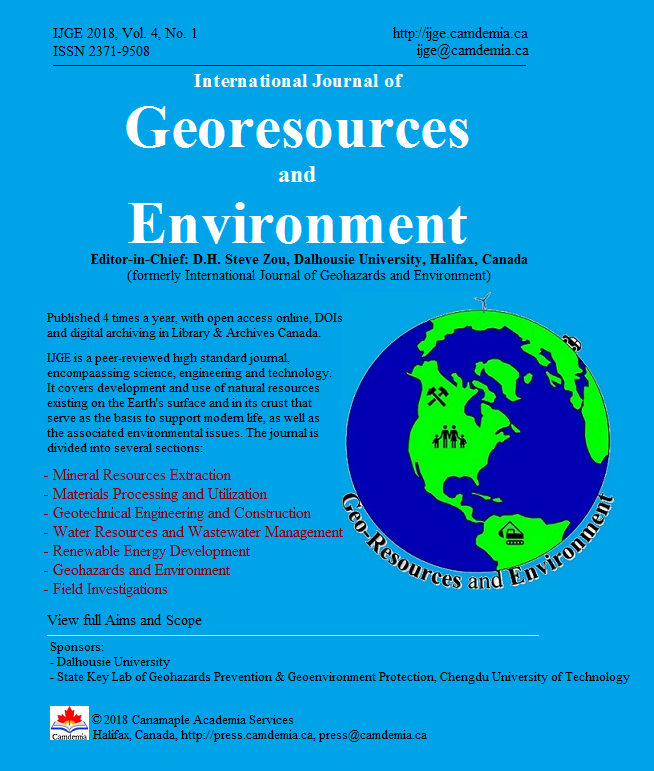Cavitation Erosion of Metallic Materials
DOI:
https://doi.org/10.15273/ijge.2018.01.001Keywords:
cavitation erosion, corrosion, mechanical properties, electrochemical behavior, passive film, stainless steel, titanium and titanium alloyAbstract
Cavitation erosion normally occurs in a fluid dynamic system, which can cause failure of metal parts. It is a complicated process involving the interaction of electrochemical corrosion and mechanical wear. In this paper, various research methods for cavitation erosion behavior are reviewed. The present techniques of cavitation erosion degree measurement and different period determination include mass loss, volume loss, pit number, pit depth and surface roughness. 2D and 3D microstructure characterization observations are applied to discuss the evolution process and micro-zone damage. Hardness, residual stress and ratio of hardness to elastic modulus are good indicators for the degradation of surface mechanical properties.
Electrochemical examinations are integrated to investigate the effect of cavitation on passive film and cavitation erosion mechanism. Furthermore, the influencing factors (mechanical properties, material chemical composition and microstructure) and the cavitation erosion characteristics of several metals (i.e. carbon steel, copper, stainless steel and titanium alloy) are introduced and summarized. Normally, the addition of Mn, Co, Cr, C and N can increase the cavitation erosion resistance. High hardness, high yield/tensile and toughness strength, good work-hardening property, fine grains are advantageous to the resistance to cavitation erosion. The cavitation erosion preferentially occurs on the lower intensity phase, which absorbs cavitation impact energy and mitigates the damage degree of a high strength phase. The interface between phases and grain boundary are also the weak spots to be attacked in the initiation and propagation of cavitation erosion. For passive metals, stainless steel and titanium alloy, the passive film is in a metastable state of depssivation/repassivation under cavitation. In a strongly corrosive medium, the synergetic effect of cavitation and corrosion promotes the thinning and semiconducting property change of the passive film.Downloads
Issue
Section
License
Copyright, Terms and Conditions
The International Journal of Geohazards and Environment (the Journal) is published by Canamaple Academia Services (the Publisher) online with open access, under a Creative Commons Attribution-Noncommercial license (CC-BY-NC) (http://creativecommons.org/licenses/by-nc/4.0/). Authors (the Authors) submitting papers (the Work) for publication in the Journal automatically agree to the following terms and conditions.
1. Under the license (CC-BY-NC), Authors give permission for others to share and reuse the Work, as long as the original source and author(s) are properly cited (i.e. a complete bibliographic citation and link to the Journal website) and the material is not used for commercial purposes. Any sharing or reuse must however indicate the original CC-BY-NC license terms of the work.
2. Authors transfer and assign to the Publisher all copyright in and to the Work. However Authors retain all proprietary rights except the copyright, related to the Work and also retain the rights a) to use, reproduce, distribute, and publicly display the Work in any medium in connection with the Authors‘ academic and professional activities, such as teaching, presentations and lectures, b) to create derivative works from the Work and to make full use of the Work in future research and publications, c) to authorize others to make any non-commercial use of the Work, d) to make both the pre-published and final-published versions available online in institutional and/or disciplinary repositories or on their own websites with a citation and link to the original paper published in the Journal.
3. Authors warrant that the Work is their original work, it is not copied from anywhere or anyone else, they are totally responsible for the authenticity, originality, validity and accuracy, and the facts and views are their own, that the Work contains no matter which is defamatory or infringes any literary or proprietary rights, intellectual property rights, or any rights of privacy, and that the Work has not been simultaneously submitted to any other journals or publishers. Authors further agree that their manuscripts whether accepted or rejected will not be returned and the rejected manuscripts will be disposed at the journal editor's discretion.
Disclaimer: The Publisher, the Journal and the editors accept no responsibility for statements or opinions expressed by authors. Use of information and materials in the Journal is the sole responsibility of users.


